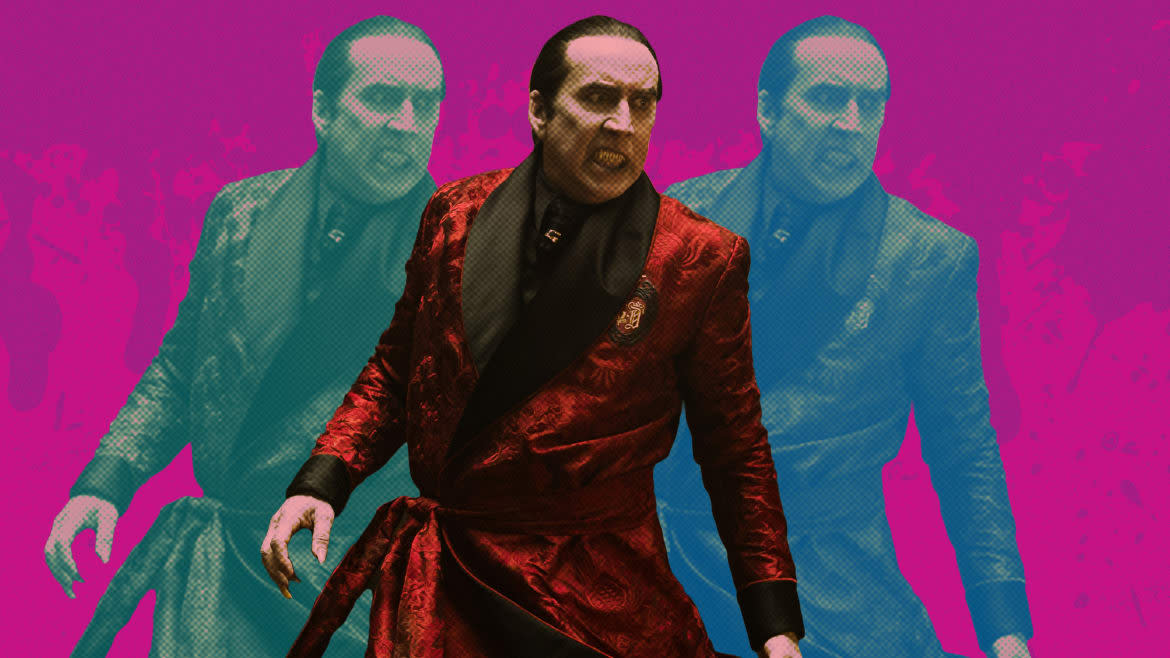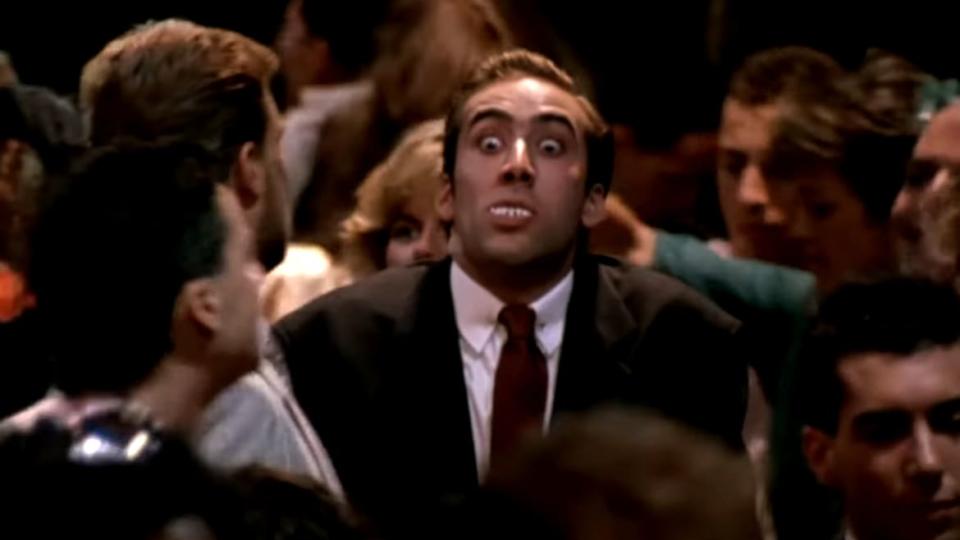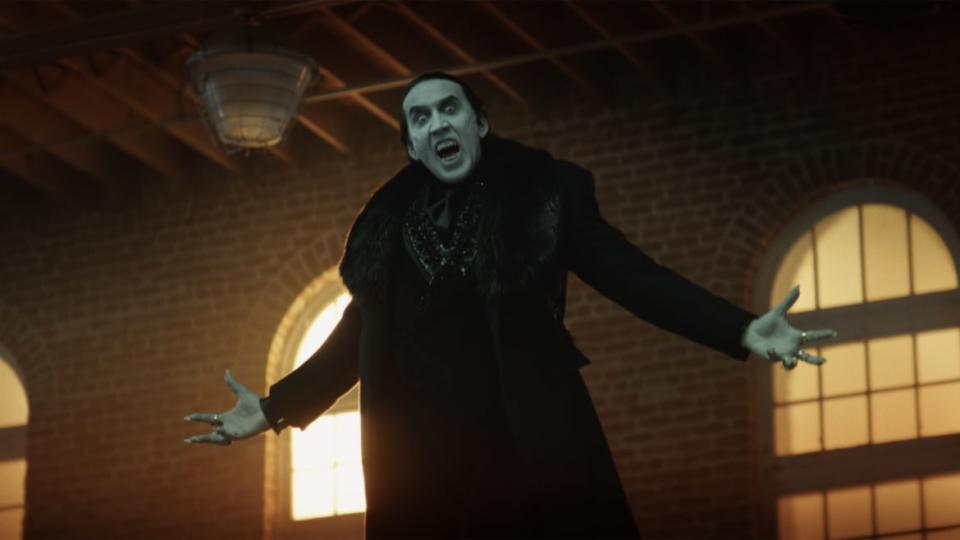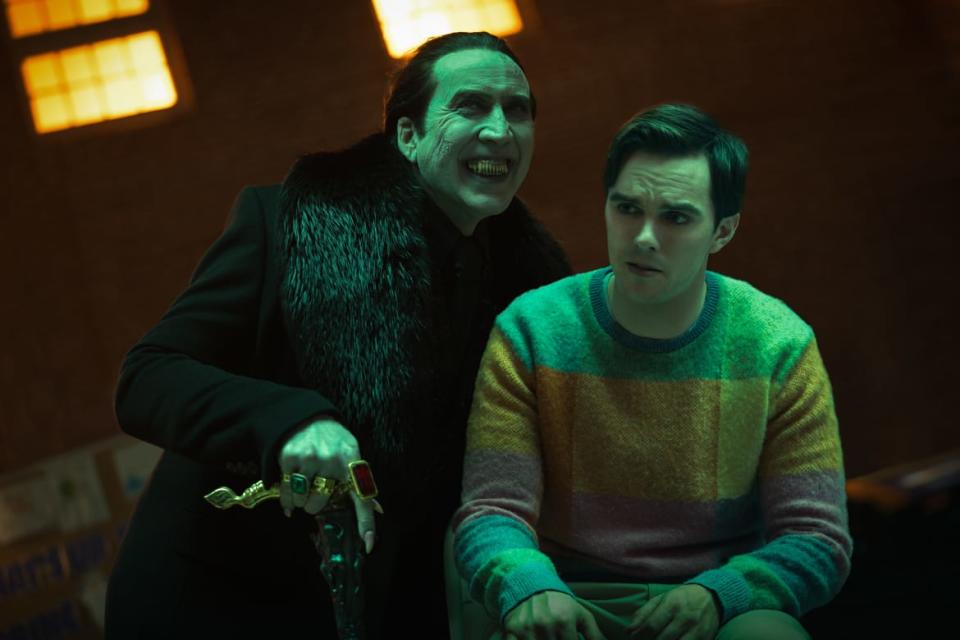Nicolas Cage in ‘Renfield’ Proves Hollywood Vampires Need an Image Consultant

Assemble 100 Hollywood vampires in a room, and they’d have less in common than you might think. Some would resemble old-world aristocracy, others millennial rave kids. We’d find vampires who spend their days dating mortals, vampires whose job it is to kill other vampires, and more recently, vampires who are just really terrible officemates.
The film industry excels at nothing if not cycling (and recycling) material, and in the case of bloodsuckers, certain thematic archetypes have formed in the century since F. W. Murnau’s Nosferatu. At first, vampires were scary. Then they were sexy. Then silly, scary again, sexy, silly, scary silly sexy…
With pop culture’s perpetual compression, the evolution accelerated to Mach speed. It was nearly fifty years from Nosferatu to Ingrid Pitt baring it all in The Vampire Lovers, and another decade until a spate of undead ’80s satire. Things went gothic with ’92’s Bram Stoker’s Dracula, violent in From Dusk till Dawn, and exploded into sexuality with the aughts’ Twilight and True Blood. Thus spins the immutable Vamp Clock, veering from horror to humor and back again. And if any actor should be struck twice by this dial, it’s clearly Nicolas Cage, who turned fanged again in last weekend’s Renfield.
Is Nicolas Cage an actor? Certainly. He’s also a quasi-normal guy just trying to pay his idiotically accrued bills, whose 10 craziest stories are featured in a listicle on this very website. In other words, if vampires are a post-monster monster, Cage is a post-actor actor. When he saunters onscreen we experience a strange, kaleidoscopic vertigo, wherein we see not a movie role but Nicolas Cage playing a movie role. Apparently, he even sees himself this way—he admitted as much with last year’s The Unbearable Weight of Massive Talent.
Is Nicolas Cage’s ‘Renfield’ the Worst Vampire Movie Ever?
When Cage received his first bloodsucking call-up in 1989, he was a promising up-and-comer who hadn’t yet smashed the fourth wall. Appropriately, a vampiric role allotted him his first and largest sledgehammer. Robert Bierman’s Vampire’s Kiss isn’t a particularly good film—it might be plain bad—but Cage’s uncanny portrayal of crackpot literary agent Peter Loew leaves you with an indelible aftertaste, a feeling of what on earth did I just watch?

Nicolas Cage in Vampire's Kiss.
“The film is dominated and destroyed by Mr. Cage’s chaotic, self-indulgent performance,” wrote New York Times film critic Caryn James. Honestly, I’m not sure Vampire’s Kiss built up enough material to tear down.
Somewhere between eating a live pigeon, shouting the entire alphabet to his psychiatrist, and skipping down a Manhattan sidewalk shouting, “I’m a vampire! I’m a vampire!” a young Cage exuded the bizarreness for which he would someday grow famous. Was Peter Loew “actually” a vampire? No one knew. Was Nicolas Cage a “good” actor? In the sense that you couldn’t look away, sure.
Three decades and 100 films later, Cage returned to Vamp Land this week with Chris McKay’s Renfield. The film is more or less a worthwhile endeavor—far better than Vampire’s Kiss. Even if most of its watchability still derives from Cage’s allure.
No longer the delusional, plastic-fanged literary agent Peter Loew, this time Cage is definitely a vampire. In fact, he’s the vampire. Dracula. Yet for all of Cage’s 34-year transformation, the corresponding shift in vampiredom—from Vampire’s Kiss to True Blood to What We Do in the Shadows—feels even more pronounced.
Nicolas Cage Stayed in Character as Dracula Even Behind the Scenes on ‘Renfield’ Set
Vampires are a subject of constant refashion because they transfix us. To ask why, we might want to catch up on our source material. “Vamps, the movie?” asks your know-it-all friend. “Have you even read the book?”
Sink Your Teeth Into History
The origins of vampiredom—and the fabrication of my metaphorical “Vamp Clock”—stem from a folk tale that came about with little forewarning in the early 1700s, when an Austrian army medic sent home correspondence that he’d seen Serbian peasants digging up bodies and burning them at the stake. When asked why, the peasants explained that these corpses had risen from the dead and killed people.

Nicolas Cage as Dracula in Renfield.
Well, added the peasants, they tended to kill already sick people. But whatever. Off went the medic’s report, kickstarting an irreversible European rumor mill. Suddenly the word “vampire” began popping up in journals, books, and Ye’ Ole Daily Bæst.
Vamp scholar Erik Butler explains that the monster slotted into an existing Church-versus-State debacle, “parodying and perverting the religious idea of resurrection.” On top of that, impoverished Serbian roots instilled vampiredom with a classist, Eastern bent, which is why famous bloodsuckers are often from places on the edge of make-believe (sorry, Transylvanians).
After a spree of vampiric gossip swept the Holy Roman Empire, those premodern Europeans “smarted up” and regained their wits. Only one person could be resurrected, they remembered. And he totally wasn’t a vampire!
But the term now ran wolf-like in the pastures of Western culture, and “Vampire” became a defamatory term for those exploiting power. That greedy Baron von Münchhausen, what a vampire. Super-yacht owners? Definitely vampires. Even Karl Marx joined the fray: “Capital is dead labor that, vampire-like, only lives by sucking living labor.”
Despite the era’s sexual repressiveness, vamps made simultaneous strides into eroticism. In Charles Baudelaire’s 1857 “Les Métamorphoses du Vampire,” the subversive Frenchman cast his bloodsucker as a pleasure-seeking lover, “Shaping her breasts against her corset’s metal bands, / Twisting and writhing like a snake on fiery sands.” Bringing the act to consummation she cries, “On all those mattresses that swoon in ecstasy / Even helpless angels damn themselves for me!”

Nicolas Cage and Nicholas Hoult in Renfield.
Long before the cinematic cycle that began with Nosferatu, literary vamps were hundreds of years in scary/silly/sexy fluctuation. With the dawn of film, the cycle’s frequency halved. As corporations remade Hollywood into a gigantic marketing stratagem, it halved again. These days, in the spirit of post-internet Dadaism, it less resembles a “cycle” than a Pollock piece.
The Blood Stops Here
Renfield markets itself as a horror comedy, but it’s more of a laugh than a scare. Yes, there’s blood—buckets and buckets of it—but it flows in an absurd and nonthreatening manner. In this way Renfield takes after its contemporaries, in particular the televised What We Do in the Shadows (which I love). Renfield’s press release informed me that the film is “based on an original idea by The Walking Dead and Invincible creator Robert Kirkman.” To that I say, really?
Sifting through Renfield for originality, what we come away with 10 times out of 10 is Cage’s performance. The story, so much as there is one, falls flat. Awkwafina does an admirable job as the star of a B plot cop drama, Nicholas Hoult reprises his milquetoast role from The Menu, and Ben Schwartz looks funny with neck tats. But without Cage, Renfield is empty calories. He carries this thing like a pail does water, and in my opinion, manages to cross some sort of finish line with it.
‘The Menu’: Eating at a Restaurant Has Never Been More Horrifying
Meanwhile the Vamp Clock continues to run haywire, and I’m concerned that if we trundle much farther down the road of satire, bloodsuckers will lose any semblance of sincerity. If the genre arrived at any kind of post-millennium peak, it was surely Tomas Alfredson’s Let the Right One In, which treats death with proper solemnity and reminds us that, oh right, meeting a vampire in the wild would be f***ing scary!
Call me maudlin, call me old-fashioned. But I need a break from the irony and shlock. I want to feel something real, like those Serbian peasants literally digging up their loved ones for fear of the undead. Until then, at least we have Nicolas Cage.
Keep obsessing! Sign up for the Daily Beast’s Obsessed newsletter and follow us on Facebook, Twitter, Instagram and TikTok.
Get the Daily Beast's biggest scoops and scandals delivered right to your inbox. Sign up now.
Stay informed and gain unlimited access to the Daily Beast's unmatched reporting. Subscribe now.

